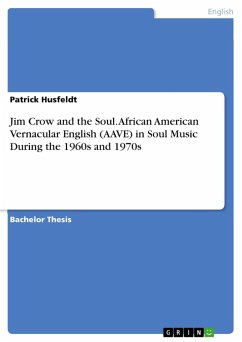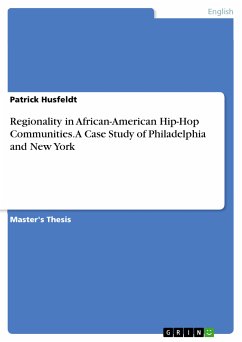
Jim Crow and the Soul. African American Vernacular English (AAVE) in Soul Music During the 1960s and 1970s (eBook, PDF)
Sofort per Download lieferbar
Statt: 27,95 €**
18,99 €
inkl. MwSt. und vom Verlag festgesetzt.
**Preis der gedruckten Ausgabe (Broschiertes Buch)
Alle Infos zum eBook verschenkenWeitere Ausgaben:

PAYBACK Punkte
0 °P sammeln!
Bachelor Thesis from the year 2016 in the subject English Language and Literature Studies - Linguistics, grade: 1,3, Christian-Albrechts-University of Kiel, language: English, abstract: The question that will be addressed in this thesis is whether dialect choice in soul music from Memphis and Detroit was, with regard to commercial success, stronger than the mostly homogeneous character of African American Vernacular English (AAVE) across all regions of the US. A detailed linguistic analysis of a selection of songs from Motown and Stax will try to investigate the extent to which that artists fr...
Bachelor Thesis from the year 2016 in the subject English Language and Literature Studies - Linguistics, grade: 1,3, Christian-Albrechts-University of Kiel, language: English, abstract: The question that will be addressed in this thesis is whether dialect choice in soul music from Memphis and Detroit was, with regard to commercial success, stronger than the mostly homogeneous character of African American Vernacular English (AAVE) across all regions of the US. A detailed linguistic analysis of a selection of songs from Motown and Stax will try to investigate the extent to which that artists from Detroit did adapt their language habits to their surrounding white fellow citizens. This might be even more interesting for northern blacks who moved away from their dialect roots in the South. With respect to a separation from the white population, which can at least be assumed for the artists' childhood and early adulthood, it appears necessary to look at certain features that were either kept or lost. In addition, the analysis will try to connect the commercial success of all included songs and artists to the language habits of the performers. First, some background for this paper's study will be provided, including the social implications of AAVE and the reference studies for the analysis. Then, the relevant phonological and grammatical variables will be listed and explained. These variables will be, with regard to the Motown and Stax data sets, analyzed in detail. Finally, the interpretation of the results will try to find an answer to the thesis of this paper.
Dieser Download kann aus rechtlichen Gründen nur mit Rechnungsadresse in A, B, BG, CY, CZ, D, DK, EW, E, FIN, F, GR, HR, H, IRL, I, LT, L, LR, M, NL, PL, P, R, S, SLO, SK ausgeliefert werden.













